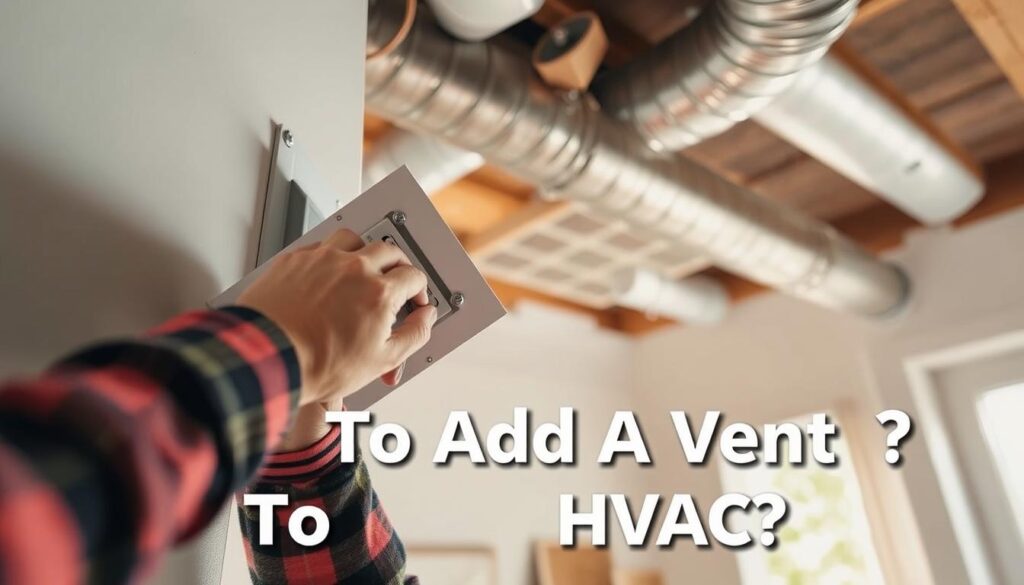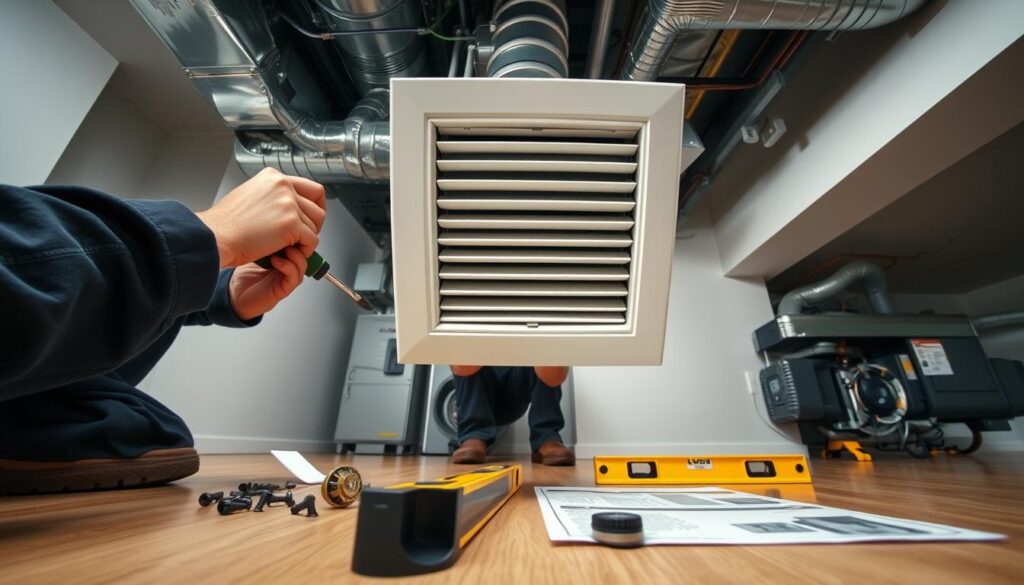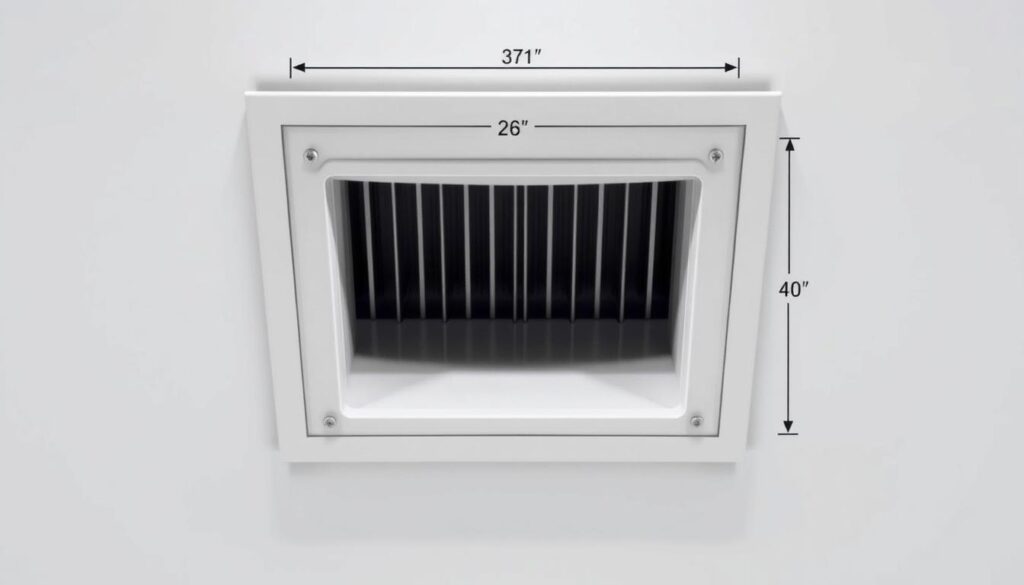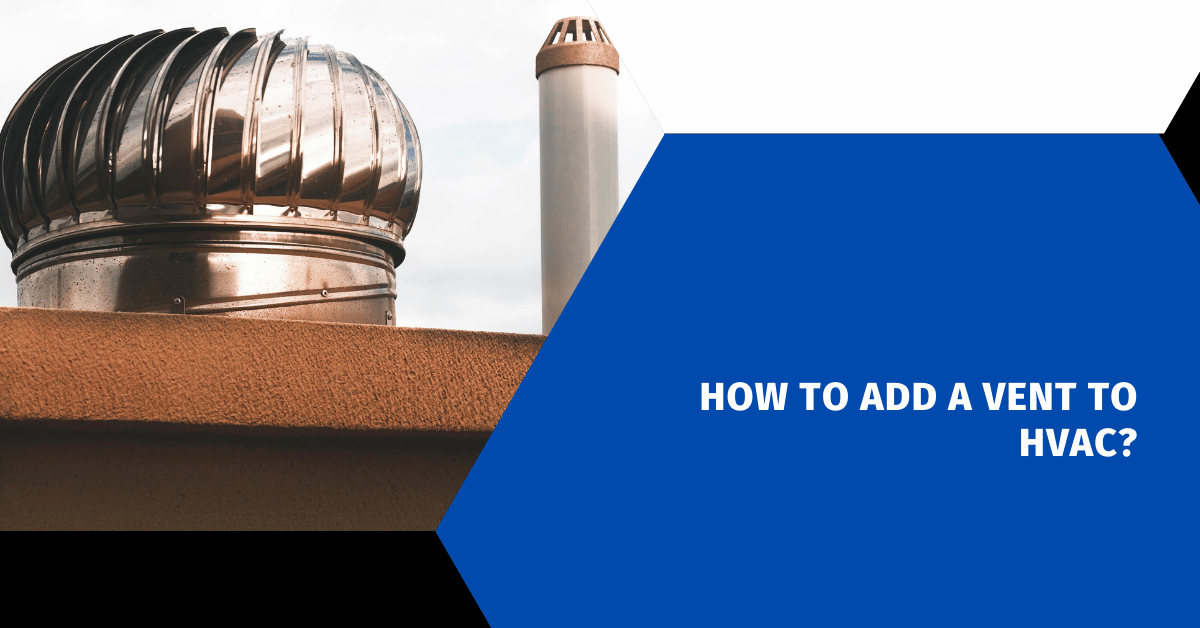How To Add A Vent To HVAC? Are you dealing with uneven temperatures at home? Or maybe you want to make your living space more comfortable? Adding a vent to your HVAC system could be the answer you’ve been looking for.

Installing an HVAC vent can change how your home feels. This is especially true when you’re turning spaces like garages or basements into living areas. To add a vent to your HVAC system, you need to plan carefully and execute with precision.
Your home’s comfort relies on good ventilation. If you want better airflow or more even temperatures, learning how to install HVAC vents is key. It can greatly improve your living space.
Key Takeaways
- Proper vent placement is crucial for optimal HVAC performance
- Adding a vent can improve overall home comfort and temperature distribution
- Professional assessment helps ensure correct HVAC modifications
- Vent installation requires specific tools and technical knowledge
- Building codes and permits are essential considerations
Table of Contents
Understanding HVAC Ventilation Basics
HVAC ventilation is key to your home’s comfort and air quality. It works hard to keep your indoor space comfortable. It manages airflow, temperature, and air circulation.
Good hvac venting uses two main types of air ducts. They work together to keep your home’s air quality and temperature right:
- Supply ducts: Send conditioned air to your rooms
- Return air ducts: Take air back to the HVAC system
Essential Duct Functions and Design
Supply ducts send cool or warm air into your rooms. Return air ducts pull indoor air back to be filtered, heated, or cooled. Then, they send it out again.
Airflow Distribution Dynamics
It’s important to have balanced airflow for even temperature and air quality. Your HVAC system needs the right duct placement and size for efficient air circulation. If not, you might get hot or cold spots, use more energy, and see your system’s performance drop.
System Efficiency Considerations
Knowing how supply and return air work together helps homeowners improve their HVAC. A well-designed system ensures a steady air exchange. This keeps your home comfy and your energy bills low.
Explore Our HVAC Shop
Looking for top-rated HVAC tools, parts, and accessories? Visit our shop and find the perfect solution for your needs.
Visit the ShopEssential Tools and Materials for Vent Installation
Getting ready for HVAC duct work needs careful planning and the right tools. Before starting your project, it’s important to gather all the necessary tools and materials. This will help you achieve a successful outcome.
- Measuring tape for precise duct measurements
- Utility knife with spare blades
- Metal cutting shears
- Cordless drill with various drill bit sizes
- Adjustable wrench
- Protective safety glasses
- Work gloves
For materials specific to HVAC duct work, you’ll need:
- Flexible or rigid ductwork
- Vent covers
- Duct tape or metal foil tape
- Insulation wrap
- Sheet metal screws
- Sealant for connecting duct sections
Professional-grade tools can be found at home improvement stores like Lowe’s or specialized HVAC supply centers. Budget-conscious DIY enthusiasts can often rent specialized tools to save money.
Pro Tip: Always measure twice and cut once to minimize waste and ensure precise HVAC duct modifications.
Investing in quality tools and materials will help you complete your vent installation efficiently and effectively. This ensures optimal airflow and system performance.
Evaluating Your Current HVAC System Capacity
Knowing your HVAC system’s capacity is key when looking to boost efficiency. Before adding a new vent, you must check several important factors. These factors help figure out if your system can handle the load.
Your home’s unique features are crucial in finding the right HVAC system. A proper check can avoid problems like system overload or not cooling enough.
Calculating Tonnage Requirements
Tonnage shows how much cooling your HVAC system can do. Here’s a quick guide to understand your system’s capacity:
- 1 ton of cooling equals 12,000 BTUs per hour
- Typical residential systems range from 1.5 to 5 tons
- General rule: 1 ton per 500-600 square feet of living space
Assessing System Efficiency Ratings
Boosting HVAC efficiency starts with knowing your system’s SEER (Seasonal Energy Efficiency Ratio) rating. A higher SEER rating means better energy use.
| SEER Rating | Efficiency Level | Energy Savings |
|---|---|---|
| 13-14 | Standard Efficiency | Baseline Performance |
| 15-16 | High Efficiency | 10-15% Energy Savings |
| 17-18 | Premium Efficiency | 15-20% Energy Savings |
| 19+ | Top-Tier Efficiency | 20-25% Energy Savings |
Measuring Square Footage Impact
Your home’s size affects your HVAC system’s performance. Getting accurate measurements is key to see if your current system can handle more vents without losing efficiency.
- Measure total living space accurately
- Consider ceiling height and room layout
- Account for insulation and window quality
Professional HVAC technicians can give a detailed look at your system’s capacity. They can suggest the best ways to improve your HVAC efficiency.
Explore Our HVAC Shop
Looking for top-rated HVAC tools, parts, and accessories? Visit our shop and find the perfect solution for your needs.
Visit the ShopHow To Add A Vent To HVAC
Adding a vent to your HVAC system needs careful planning and precise steps. The hvac vent installation process is key for good airflow and system efficiency.

Before starting, you’ll need the right tools and materials. Your toolkit should include:
- Tape measure
- Utility knife
- Metal cutting shears
- Ductwork
- Protective gloves
- Sealant
First, find the best spot for your new vent. Careful placement is crucial for maximizing air circulation. Think about these important factors:
- Distance from existing ductwork
- Room layout and furniture positioning
- Proximity to return air system
- Structural obstacles
“Proper vent placement can improve your HVAC system’s overall performance by up to 30%.” – HVAC Professional Association
Then, measure and cut the ductwork accurately. Make sure connections are tight and use quality sealant to avoid air leaks. Badly sealed ducts can lower system efficiency and raise energy costs.
Don’t forget to check local building codes and get the needed permits before starting. Safety and following rules are key when changing your home’s heating and cooling system.
Planning the Ductwork Route and Location
Creating a good home hvac venting system needs careful planning. Your ductwork project must map air paths well for best performance and energy use.
- Existing structural elements
- Current HVAC system configuration
- Home’s architectural layout
- Potential airflow obstructions
Determining Optimal Vent Placement
Finding the best spot for your new vent is key. Good placement means balanced air flow and better system efficiency. Here are some tips:
- Find areas with bad air circulation
- Check how close to existing ductwork
- Look at room temperature differences
- Check if it’s easy to access the structure
Mapping Air Flow Pathways
Understanding air movement is crucial for ductwork extension. Air should move from high points near the furnace or air handler, down walls for even temperature.
Pro Tip: Always measure twice and cut once when planning your ductwork route to minimize potential installation errors.
Experts say to make a detailed sketch of ductwork paths. This helps spot problems before you start installing.
Explore Our HVAC Shop
Looking for top-rated HVAC tools, parts, and accessories? Visit our shop and find the perfect solution for your needs.
Visit the ShopCreating and Sizing Vent Openings

Cutting precise vent openings is key for better hvac airflow. The size of your vents affects your system’s performance and efficiency. Before starting, make sure you have the right tools and a solid plan.
When making vent openings, consider a few important things:
- Wall material composition
- Existing structural elements
- Recommended airflow dimensions
- Mounting space requirements
Measuring accurately is vital for good hvac airflow. Use a tape measure and marker to mark your vent area. Standard sizes range from 16×20 inches to 20×25 inches, based on your home’s size and HVAC system.
Here are the tools you’ll need for vent openings:
- Reciprocating saw
- Stud finder
- Measuring tape
- Protective safety glasses
- Dust mask
Pro tip: Always double-check measurements before cutting to prevent costly mistakes in your hvac airflow improvement project.
Precision matters more than speed when creating vent openings.
Don’t forget to leave enough space for mounting the vent. This ensures it’s installed right and keeps air from leaking out, which can hurt your HVAC system’s efficiency.
Installing Return Air Ducts and Components
Understanding the role of return air vents is key for your HVAC system’s performance. Your home’s comfort relies on their proper installation and placement.
Adding return air vents needs careful planning and precise execution. The process involves several key steps to ensure efficient airflow and system functionality.
Connecting New Ductwork to Existing System
Integrating new ductwork demands attention to detail. Follow these critical guidelines:
- Measure existing duct dimensions accurately
- Select compatible materials for seamless connection
- Use professional-grade sealing techniques
- Ensure airtight connections to prevent energy loss
Managing Corner Transitions
Corner transitions can affect airflow. Proper management prevents performance issues:
| Transition Type | Best Practices | Potential Challenges |
|---|---|---|
| 90-Degree Corners | Use radius elbow fittings | Reduced airflow efficiency |
| Acute Angles | Install turning vanes | Increased air resistance |
By implementing these strategic hvac duct modifications, you’ll create a more efficient and responsive ventilation system. This optimizes your home’s comfort and energy performance.
Explore Our HVAC Shop
Looking for top-rated HVAC tools, parts, and accessories? Visit our shop and find the perfect solution for your needs.
Visit the ShopBasement and Utility Room Vent Considerations
Installing home hvac venting in basements and utility rooms comes with its own set of challenges. These areas have unique conditions that affect your HVAC system’s performance and efficiency.
Key considerations for home hvac venting in basement areas include:
- Moisture control and prevention of humidity buildup
- Temperature regulation between basement and upper floors
- Proper airflow management
- Structural limitations and space constraints
Basement return air ducts are crucial for better home ventilation. By placing vents strategically, you can improve air circulation and temperature balance in your home.
| Basement Venting Aspect | Recommended Strategy |
|---|---|
| Moisture Management | Use sealed ductwork with vapor barriers |
| Air Temperature Equalization | Install multiple return air vents at different levels |
| Airflow Optimization | Ensure proper sizing and clean ductwork regularly |
Professional tip: Always consult an HVAC specialist to assess your specific basement venting requirements and potential system modifications.
Safety Measures and Building Codes
Understanding safety rules is key when you’re working on HVAC venting. Homeowners and contractors need to know about building codes and permits. This keeps your property safe and makes sure your HVAC system is installed right.
Following local and national safety standards is essential for HVAC venting. Each area has its own rules for vent installation.
Local Regulations and Permits
Before you start any HVAC work, you must:
- Contact your local building department
- Get the permits you need
- Schedule inspections
- Check if you’re in the right zone
Fire Safety Requirements
Fire safety is very important when you’re installing HVAC vents. You need to think about:
- Keeping vents away from flammable stuff
- Using fire-safe materials in certain spots
- Putting in fire stops
- Making sure vents have good airflow
Not following building codes can lead to fines, system changes, or insurance issues.
Professional HVAC techs say always check with local building authorities before changing your ventilation system.
Explore Our HVAC Shop
Looking for top-rated HVAC tools, parts, and accessories? Visit our shop and find the perfect solution for your needs.
Visit the ShopMaximizing HVAC System Efficiency After Installation
After installing a new vent, your main goal is to boost HVAC efficiency. Optimizing your system ensures it works at its best. This means better heating and cooling for your home.
To increase HVAC efficiency, follow these steps:
- Do a full system balance check
- Adjust your thermostat for the best performance
- Clean and check air filters every month
- Seal any air leaks in ductwork
Regular maintenance is key to keeping your HVAC system running smoothly. Experts say to get bi-annual inspections to catch problems early.
Using energy-saving methods can also help. Here are some tips:
- Get programmable or smart thermostats
- Use ceiling fans for better air flow
- Make sure your home is well-insulated
- Keep the temperature steady
Regular maintenance can cut energy use by up to 15%. It also makes your HVAC system last longer.
Keep an eye on how your system is doing. Check your energy bills, listen for odd sounds, and watch for temperature changes. Digital tools and smart home tech can help you track your HVAC’s efficiency.
Conclusion
Adding a vent to your HVAC system can make your home more comfortable and improve air flow. When you install a vent, you need to think about your system’s size and plan carefully. It’s important to know how to add a vent to your HVAC system, which takes patience and technical skills.
Some homeowners might try to do it themselves, but for complex jobs, getting a pro is best. They can make sure the vent is the right size and in the best spot. They also follow local building codes. Your goal is to have a system that keeps the air clean and the temperature even.
When you install vents, think about saving energy and keeping your system working well for a long time. Good planning and careful work lead to better air flow and lower energy bills. This makes your home more comfortable.
Experts say it’s smart to check your HVAC system often to keep it running well. Knowing how ventilation works helps you make smart choices for your home’s heating and cooling.
FAQ
How do I know if I need to add a new vent to my HVAC system?
Can I add a vent to my HVAC system by myself, or should I hire a professional?
What tools will I need to add a new vent to my HVAC system?
How do I determine the right location for a new HVAC vent?
What are the potential risks of improper vent installation?
How much does it cost to add a new vent to an HVAC system?
How do I know if I need to add a new vent to my HVAC system?
Can I add a vent to my HVAC system by myself, or should I hire a professional?
What tools will I need to add a new vent to my HVAC system?
How do I determine the right location for a new HVAC vent?
What are the potential risks of improper vent installation?
How much does it cost to add a new vent to an HVAC system?
FAQ
How do I know if I need to add a new vent to my HVAC system?
You might need a new vent if your home heats or cools unevenly. This includes hot or cold spots. Also, if you’ve added more space or renovated, you might need one.
Signs of poor airflow include stuffy rooms and inconsistent temperatures. High energy bills can also be a sign.
Can I add a vent to my HVAC system by myself, or should I hire a professional?
DIY fans might try vent installation. But, it’s safer to get a pro. They check if your system can handle it and place vents right.
They also make sure it won’t mess up your system’s efficiency or void warranties.
What tools will I need to add a new vent to my HVAC system?
You’ll need a tape measure, pencil, and drill. Also, a reciprocating saw, sheet metal cutters, and a level. Don’t forget safety glasses and gloves.
For tougher jobs, you might need duct crimpers, tin snips, and a duct stretcher.
How do I determine the right location for a new HVAC vent?
Think about room use and furniture. Vents should be on exterior walls, away from windows and doors. They should help air flow well.
Avoid vents behind furniture or where air can’t move freely.
What are the potential risks of improper vent installation?
Bad installation can make your system less efficient. This means higher energy costs and uneven heating and cooling.
It can also damage your system and harm indoor air quality. It might mess with air pressure and void your warranty.
How much does it cost to add a new vent to an HVAC system?
Costs vary based on the job’s complexity and your home’s layout. DIY can cost 0-0 in materials.
Professional work can cost 0 to
FAQ
How do I know if I need to add a new vent to my HVAC system?
You might need a new vent if your home heats or cools unevenly. This includes hot or cold spots. Also, if you’ve added more space or renovated, you might need one.
Signs of poor airflow include stuffy rooms and inconsistent temperatures. High energy bills can also be a sign.
Can I add a vent to my HVAC system by myself, or should I hire a professional?
DIY fans might try vent installation. But, it’s safer to get a pro. They check if your system can handle it and place vents right.
They also make sure it won’t mess up your system’s efficiency or void warranties.
What tools will I need to add a new vent to my HVAC system?
You’ll need a tape measure, pencil, and drill. Also, a reciprocating saw, sheet metal cutters, and a level. Don’t forget safety glasses and gloves.
For tougher jobs, you might need duct crimpers, tin snips, and a duct stretcher.
How do I determine the right location for a new HVAC vent?
Think about room use and furniture. Vents should be on exterior walls, away from windows and doors. They should help air flow well.
Avoid vents behind furniture or where air can’t move freely.
What are the potential risks of improper vent installation?
Bad installation can make your system less efficient. This means higher energy costs and uneven heating and cooling.
It can also damage your system and harm indoor air quality. It might mess with air pressure and void your warranty.
How much does it cost to add a new vent to an HVAC system?
Costs vary based on the job’s complexity and your home’s layout. DIY can cost $100-$300 in materials.
Professional work can cost $500 to $1,500, depending on the job.
Do I need a permit to add a vent to my HVAC system?
Permits depend on where you live. Many places need them for HVAC work. They check if the work meets local codes and safety standards.
Check with your local building department or a pro to see if you need one.
How long does it typically take to add a new vent?
DIY jobs can take 2 to 6 hours. Pros might do it faster. The time depends on your ductwork, the vent’s location, and any surprises.
Will adding a new vent improve my home’s energy efficiency?
Yes, if done right. It balances airflow and reduces system strain. This leads to better temperature control.
But, bad installation can hurt efficiency. So, be careful.
What maintenance is required after installing a new HVAC vent?
Keep air filters clean and check the vent and ducts for damage. Have a pro check your system yearly.
This keeps it running well.
,500, depending on the job.
Do I need a permit to add a vent to my HVAC system?
Permits depend on where you live. Many places need them for HVAC work. They check if the work meets local codes and safety standards.
Check with your local building department or a pro to see if you need one.
How long does it typically take to add a new vent?
DIY jobs can take 2 to 6 hours. Pros might do it faster. The time depends on your ductwork, the vent’s location, and any surprises.
Will adding a new vent improve my home’s energy efficiency?
Yes, if done right. It balances airflow and reduces system strain. This leads to better temperature control.
But, bad installation can hurt efficiency. So, be careful.
What maintenance is required after installing a new HVAC vent?
Keep air filters clean and check the vent and ducts for damage. Have a pro check your system yearly.
This keeps it running well.

